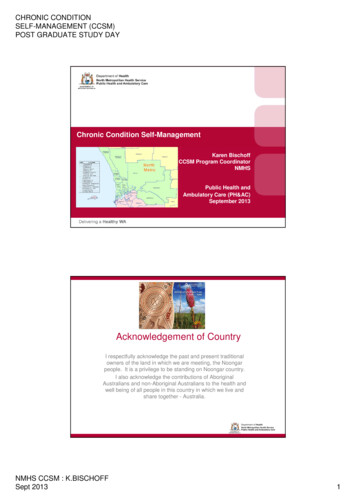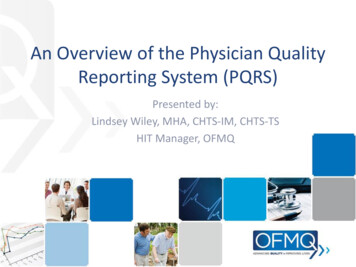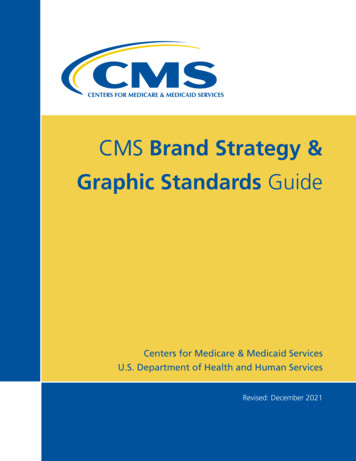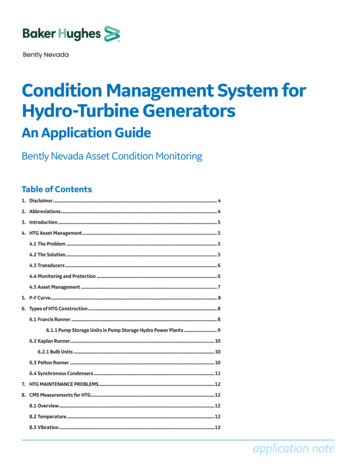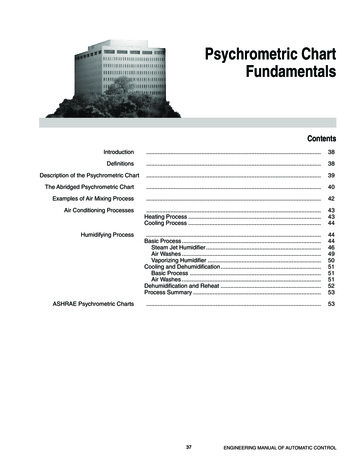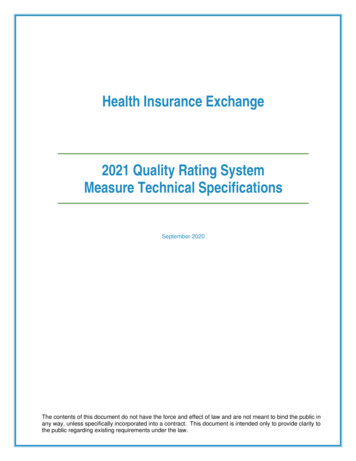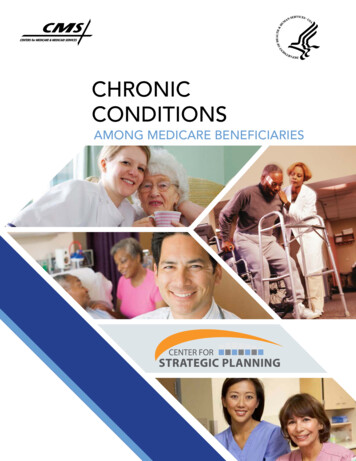
Transcription
CHRONICCONDITIONSAMONG MEDICARE BENEFICIARIES2008
1CONTENTS2 List of Figures3 Introduction4 Section 1: Demographics and Prevalence15 Section 2: Medicare Service Utilization23 Section 3: Medicare Spending29 Methodology and Data SourceCopyright informationAll material contained in this report is in the public domain andmay be used and reprinted without special permission; citation asto source, however, is appreciated.Suggested citationCenters for Medicare & Medicaid Services. Chronic Conditionsamong Medicare Beneficiaries, Chart Book. Baltimore, MD. 2011.AcknowledgementsThis report was prepared by the Centers for Medicare & MedicaidServices. The content of this chart book was developed byKimberly A. Lochner, under the direction of Christine S. Cox,with data and technical assistance provided by Stephanie Bartee,Gloria Wheatcroft, James Krometis and Christopher Powers.U.S. Department of Health and Human ServicesKathleen SebeliusSecretaryCenters for Medicare & Medicaid ServicesMarilyn TavennerCMS Administrator (Acting)CMS, Center for Strategic PlanningAnthony RodgersCSP Deputy Administrator and Director2011 Centers for Medicare & Medicaid ServicesCenter for Strategic Planning
Chronic Conditions Among Medicare BeneficiariesLIST OF FIGURES2List of Figures(click on figure number to go to specific data chart)Section 1: Demographics and PrevalenceFigures 1.11.1a Percentage of Medicare FFS Beneficiaries withthe 15 Selected Chronic Conditions: 20081.1b Percentage of Medicare FFS Beneficiaries withthe 15 Selected Chronic Conditions by Age: 20081.1c Percentage of Medicare FFS Beneficiaries withthe 15 Selected Chronic Conditions by Sex: 20081.1d Percentage of Medicare FFS Beneficiaries withthe 15 Selected Chronic Conditions by DualEligibility Status: 2008Figure 1.2 Co-morbidity among Chronic Conditions forMedicare FFS Beneficiaries with the Condition:2008Figures 1.31.3a Percentage of Medicare FFS Beneficiaries byNumber of Chronic Conditions: 2008Figure 2.5 Percentage of Medicare FFS Beneficiaries byNumber of Emergency Room Visits and Number ofChronic Conditions: 2008Figures 2.62.6a Percentage of Hospital Admissions with aReadmission within 30 days by Number of ChronicConditions: 20082.6b Percentage of Hospital Admissions with aReadmission within 30 days by Number of ChronicConditions and Age: 20082.6c Percentage of Hospital Admissions with aReadmission within 30 days by Number of ChronicConditions and Sex: 20082.6d Percentage of Hospital Admissions with aReadmission within 30 days by Number of ChronicConditions and Dual Eligibility Status: 20081.3b Percentage of Medicare FFS Beneficiaries byNumber of Chronic Conditions and Age: 2008Section 3: Medicare Spending1.3c Percentage of Medicare FFS Beneficiaries byNumber of Chronic Conditions and Sex: 20081.3d Percentage of Medicare FFS Beneficiariesby Number of Chronic Conditions and Race/Ethnicity: 20081.3e Percentage of Medicare FFS Beneficiaries byNumber of Chronic Conditions and Dual EligibilityStatus: 2008Section 2: Medicare Service UtilizationFigure 2.1 Percentage of Medicare FFS Beneficiaries byNumber of Inpatient Admissions and Number ofChronic Conditions: 2008Figure 2.2 Percentage of Medicare FFS Beneficiaries with atleast one Post-Acute Care (PAC) visit by Numberof Chronic Conditions: 2008Figure 2.3 Percentage of Medicare FFS Beneficiaries byNumber of Home Health Visits and Number ofChronic Conditions: 2008Figure 2.4 Percentage of Medicare FFS Beneficiaries byNumber of Physician Office Visits and Number ofChronic Conditions: 20082011 Centers for Medicare & Medicaid ServicesFigures 3.13.1a Per Capita Medicare Spending for Medicare FFSBeneficiaries by Number of Chronic Conditions:20083.1b Per Capita Medicare Spending for Medicare FFSBeneficiaries by Number of Chronic Conditions andAge: 20083.1c Per Capita Medicare Spending for Medicare FFSBeneficiaries by Number of Chronic Conditions andSex: 20083.1d. Per Capita Medicare Spending for Medicare FFSBeneficiaries by Number of Chronic Conditions andDual Eligibility Status: 2008Figure 3.2 Distribution of Medicare FFS Beneficiaries byNumber of Chronic Conditions and Total MedicareSpending: 2008Figure 3.3 Spending on Medicare Services as a Percentageof Total Medicare Spending Among Medicare FFSBeneficiaries by Number of Chronic Conditions:2008Figure 3.4 Per Capita Gross Drug Costs for Medicare FFSBeneficiaries with Part D coverage by Number ofChronic Conditions: 2008Center for Strategic Planning
Chronic Conditions Among Medicare Beneficiaries3IntroductionINTRODUCTIONChronic Conditions among MedicareBeneficiaries is a chart book prepared by theCenters for Medicare & Medicaid Services(CMS) and created to provide an overview ofchronic conditions among Medicare beneficiaries.The chart book highlights the prevalence of chronicconditions among Medicare beneficiaries and theimpact of chronic conditions on Medicare serviceutilization and spending. The prevalence and costsof chronic health conditions among Medicarebeneficiaries have far-reaching implications for theMedicare system. Not only are conditions suchas hypertension, high cholesterol, heart diseaseand diabetes highly prevalent among Medicarebeneficiaries, but most beneficiaries have two ormore chronic conditions. Multiple chronic conditionsincrease the risks for poor outcomes such asmortality and functional limitations as well as therisk of high cost services such as hospitalizationsand emergency room visits. CMS is committedto providing its beneficiaries with access to highquality, coordinated care in order to maintain healthand functioning, while at the same time controllinghealth care costs. In order to meet this challenge,understanding chronic conditions among theMedicare population is extremely important.The information available from this report isintended to provide health policymakers andthe public health research community a betterunderstanding of the burden of chronic conditionsamong the Medicare fee for service (FFS)1population and provide preliminary insights into thetargeting of prevention and management strategiesthat will improve care and reduce costs for thosewith chronic conditions.We selected 15 common chronic conditions that areavailable in the CMS Chronic Condition Warehouse(CCW) research files that also correspond with thelist of chronic conditions used to define multiplechronic conditions by the Department of Healthand Human Services Strategic Framework onMultiple Chronic Conditions.1 Chronic conditionswere examined for nearly 31 million Medicarebeneficiaries, who were continuously enrolled inthe Medicare fee for service program in 2008. Acomplete description of the selection of chronicconditions and inclusion criteria for the studypopulation can be found in the Methodology andData Source section.This chart book builds upon the RWJF chart book,Chronic Care: Making the Case for Ongoing Care2,which was not focused on the Medicare population,but did examine the impact of chronic conditionson individuals, their caregivers and the health caresystem. The chart book also has benefitted fromcollaboration with the U.S. Department of Healthand Human Services (HHS) Strategic Frameworkon Multiple Chronic Conditions. The information inthis chart book is available for use and reproductionwithout charge; permission from the authors to usethe charts is not necessary. U.S. Department of Health and Human Services. Optimum Health and Quality of Life for Individuals with Multiple ChronicConditions. December 2010. Multiple Chronic Conditions – A Strategic Framework: Washington, DC. Available athttp://www.hhs.gov/ash/initiatives/mcc/mcc framework.pdf, accessed September 28, 2011.Anderson G. Chronic Care: Making the Case for Ongoing Care. Princeton, NJ: Robert Wood Johnson Foundation, 2010. Available2 at re.chartbook.pdf, accessed September 28, 2011.2011 Centers for Medicare & Medicaid ServicesCenter for Strategic Planning
Chronic Conditions Among Medicare Beneficiaries4Section 1SECTION 1: DEMOGRAPHICS ANDPREVALENCEThe HHS Strategic Framework definesmultiple chronic conditions (MCC) ashaving two or more conditions. In 2008,for our study population, two-thirds, or 20.7million beneficiaries, had at least two or morechronic conditions. As the number of Medicarebeneficiaries with chronic conditions isexpected to increase, it is important to identifynot only the prevalence and severity of specificconditions, but also identify the co-morbidityamong these conditions. In fact, a complexpicture of chronic conditions emerges whenspecific combinations of chronic conditionsare considered as some chronic conditionsare highly co-morbid while others tend tohave lower rates of co-morbidity. Given thehigh prevalence of co-morbidity, focusingon MCC is essential towards furthering ourunderstanding of the scope of the problem,identifying research gaps and targetinginterventions. In addition, we must alsounderstand the variation in chronic conditionsand MCC across demographic groups. Forexample, as women live longer than men theprevalence of specific and multiple chronicconditions will be higher for them. Similarly,chronic conditions tend to be more prevalentamong beneficiaries eligible for Medicare andMedicaid benefits, known as the dual eligiblebeneficiaries. Dual eligible beneficiaries are avulnerable population, with most living belowpoverty and comprised of both beneficiarieswho are disabled (approximately 40% areunder age 65 and eligible for Medicare due toa disability) or 85 years of age and older (14%).“Hypertension was the mostcommon chronic conditionand this was true across agegroups, for men and womenas well as dual-eligibles”2011 Centers for Medicare & Medicaid ServicesCenter for Strategic Planning
Chronic Conditions Among Medicare Beneficiaries5Section 1Percentage of Medicare FFS Beneficiaries with the 15 Selected Chronic Conditions: 2008Figure isease32%IDiabetes27%Arthri rialfibrilla on8%Cancer6%Asthma4%Stroke4%Data HighlightsThe most common chronicconditions among Medicarebeneficiaries were: hypertension (56%) high cholesterol (43%)3%) heart disease (32%)2011 Centers for Medicare & Medicaid ServicesCenter for Strategic Planning diabetes (27%) arthritis (21%)
Chronic Conditions Among Medicare Beneficiaries6Section 1Percentage of Medicare FFS Beneficiaries with the 15 Selected Chronic Conditions by Age: 2008Figure sArthri4s1ϴ%11%11%65 yrs “Chronic conditions weremore prevalent among agedbeneficiariesbut depressionwas morecommonfor disabledbeneficiaries”2011 Centers for Medicare & Medicaid ServicesCenter for Strategic PlanningData HighlightsBeneficiaries less than65 years of age (who areprimarily disabled) were2.3 times as likely tohave depression and 1.7times as likely to haveasthma, compared toaged beneficiaries.
Chronic Conditions Among Medicare Beneficiaries7Section 1Percentage of Medicare FFS Beneficiaries with the 15 Selected Chronic Conditions by Sex: 2008Figure %5%3%Data Highlights8%Women were 1.7 times aslikely to have arthritis ordepression while men were1.3 times more likely to haveischemic heart disease.6%4%4%“Chronic conditionsvaried by sex”2011 Centers for Medicare & Medicaid ServicesCenter for Strategic Planning59%
Chronic Conditions Among Medicare Beneficiaries8Section 1Percentage of Medicare FFS Beneficiaries with the 15 Selected Chronic Conditionsby Dual Eligibility Status: 2008Figure 16%8%“Most chronic conditionswere more prevalent fordual-eligible beneficiaries.”7%7%6%Data Highlights Dual eligible beneficiaries were more than twice as likelyto have depression or Alzheimer’s disease. lmost one-quarter of dual eligibles had heart failure,Awhich was 60% higher than those beneficiaries notreceiving Medicaid benefits.2011 Centers for Medicare & Medicaid ServicesNon- r44%33%32%Center for Strategic Planning
Chronic Conditions Among Medicare Beneficiaries9Section 1Co-morbidity Among Chronic Conditions for Medicare FFS Beneficiarieswith the Condition: 2008Figure 1.2Data Highlights “Co-morbidity among chronicconditions is very common.” 2011 Centers for Medicare & Medicaid Services even percent of beneficiaries withShypertension had no other condition present,while 21% had 5 or more additional conditions. Stroke and heart failure were highly co-morbidconditions with about 50% of beneficiarieswith these conditions having 5 or moreadditional chronic health conditions. This pattern of co-morbidity held for men andwomen, with beneficiaries 65 years and olderand dual-eligibles having greater co-morbidity.Center for Strategic Planning
Chronic Conditions Among Medicare Beneficiaries10Section 1Percentage of Medicare FFS Beneficiaries by Number of Chronic Conditions: 2008Figure 1.3a33%33%13%12%9%0to12to3456 NumberofChronicCondi;onsData Highlights2 out of 3Among the 15 chronic conditionsexamined, the prevalence ofMCC was high, with two-thirds ofbeneficiaries having two or morechronic conditions and 12% having6 or more chronic conditions.“Two- thirds of Medicarebeneficiaries had multiplechronic conditions”2011 Centers for Medicare & Medicaid ServicesCenter for Strategic Planning
Chronic Conditions Among Medicare Beneficiaries11Section 1Percentage of Medicare FFS Beneficiaries by Number of Chronic Conditions and Age: 2008Figure 1.3b50%Lessthan65years65to74years75to84years85 %0to12to348%8%7%56 NumberofChronicCondi onschrelpltimuoni65 Yearscdicontions85 Years75 YearsOne-half of beneficiaries less than65 years of age had two or morechronic conditions compared to:“Multiple chronic conditionsincreased with age”2011 Centers for Medicare & Medicaid ServicesData HighlightsCenter for Strategic Planning ixty-two percent of thoseS65-74 years; eventy-six percent ofSthose 75-84 years; and ighty-one percent ofEbeneficiaries 85 yearsand older.
Chronic Conditions Among Medicare Beneficiaries12Section 1Percentage of Medicare FFS Beneficiaries by Number of Chronic Conditions and Sex: 2008Figure 6 NumberofChronicCondi9ons“Women were more likelythan men to have multiplechronic conditions”70% 63 %2011 Centers for Medicare & Medicaid ServicesCenter for Strategic PlanningData HighlightsSeventy percent of women hadtwo or more chronic conditionscompared to 63% of men.
Chronic Conditions Among Medicare Beneficiaries13Section 1Percentage of Medicare FFS Beneficiaries by Number of Chronic Conditionsand Race/Ethnicity: 2008Figure 0to12to34NumberofChronicCondi9ons“Multiple chronic conditions variedlittle across race and ethnic groups”2011 Centers for Medicare & Medicaid ServicesCenter for Strategic Planning15%14%13%13%13%13%511%6
Chronic Conditions Among Medicare Beneficiaries14Section 1Percentage of Medicare FFS Beneficiaries by Number of Chronic Conditionsand Dual Eligibility Status: 2008Figure 1.3e34%34%30%28%DualNon- ndi9ons56 Data Highlights“Dual-eligible beneficiarieswere more likely to havemultiple chronic conditions.” Seventy percent of dual-eligiblebeneficiaries had two or moreconditions compared to 66% ofnon duals. 2011 Centers for Medicare & Medicaid ServicesCenter for Strategic Planning ual-eligible beneficiaries wereDalmost twice as likely to have 6or more chronic conditions.
Chronic Conditions Among Medicare Beneficiaries15Section 2SECTION 2: MEDICARE SERVICEUTILIZATIONMedicare beneficiaries with multiplechronic conditions are the heaviestusers of health care services. Asthe number of chronic conditions increases,utilization of health care services increasesalong with corresponding increases in healthcare costs. For example, hospitalizationsare an important driver of health care costs,thus it is critical to know the impact chronicconditions have on inpatient admissions. In2008, for our study population, about one infive Medicare beneficiaries were admitted toa hospital, resulting in costs over 100 billiondollars. However, beneficiaries with 6 or morechronic conditions, of whom two-thirds werehospitalized, accounted for about one-halfof Medicare spending on hospitalizations.In addition, there has been rapid growth inMedicare spending for post-acute care (PAC),which is provided in four settings - skillednursing facilities, long-term care hospitals,inpatient rehabilitation facilities and thehome (i.e. home health visits). Overall, 13% ofMedicare beneficiaries received post-acute careduring the year, resulting in costs of 48 billiondollars3. Beneficiaries with 6 or more chronicconditions accounted for almost 70% of thesePAC costs. Similarly avoiding unnecessaryhospital readmissions and emergency roomvisits, which can indicate poor quality of careor lack of coordinated care, is importantfor improving the health care outcomes ofbeneficiaries with multiple chronic conditionsand controlling Medicare costs.This report examined several major Medicareservice types – inpatient hospitalizations,post-acute care (PAC) services, home healthvisits, physician office visits, emergency roomvisits and 30-day hospital readmissions – andutilization increased for all of them as thenumber of chronic conditions increased.“Beneficiaries withmultiple chronicconditions weremore likely to behospitalized and hadmore hospitalizationsduring the year”Although post-acute care services generally are received after discharge from an acute carehospitalization, our estimates of beneficiaries utilizing a PAC service is based upon our total studypopulation not only those beneficiaries discharged from an acute care hospitalization.3 2011 Centers for Medicare & Medicaid ServicesCenter for Strategic Planning
Chronic Conditions Among Medicare Beneficiaries16Section 2Percentage of Medicare FFS Beneficiaries by Number of Inpatient Admissionsand Number of Chronic Conditions: 2008Figure 2.10Inpa entadmissions100%3%1Inpa entadmission0.2%2Inpa entadmissions0.9%2%3 Inpa AllFFSBeneficiaries0to12to3456 NumberofChronicCondi onsData Highlights nly 4% of beneficiaries with 0 or 1 chronic conditionOwere hospitalized and less than 1% were hospitalized 3or more times during the year. mong beneficiaries with 2 or 3 chronic conditions,A14% were hospitalized and about 1% had 3 or morehospitalizations during the year. lmost two-thirds of beneficiaries with 6 or more chronicAconditions were hospitalized and about 18% had 3 ormore hospitalizations during the year.2011 Centers for Medicare & Medicaid ServicesCenter for Strategic Planning
Chronic Conditions Among Medicare Beneficiaries17Section 2Percentage of Medicare FFS Beneficiaries with at Least One Post-Acute Care Visitby Number of Chronic Conditions: 2008Figure 2.249%25%15%13%7%2%All FFSBeneficiaries0 to 12 to 3456 Number of Chronic ConditionsData Highlights“There was a steady increasein the percentage of Medicarebeneficiaries receiving post-acutecare services as the number ofchronic conditions increased” nly 2% of beneficiaries with 0 or 1Ochronic condition received care in apost-acute care setting compared to: even percent with 2 or 3Schronic conditions; ifteen percent with 4 chronicFconditions; ne-quarter with 5 chronicOconditions and; Almost one-half of thebeneficiaries with 6 or morechronic conditions.2011 Centers for Medicare & Medicaid ServicesCenter for Strategic Planning
Chronic Conditions Among Medicare Beneficiaries18Section 2Percentage of Medicare FFS Beneficiaries by Number of Home Health Visitsand Number of Chronic Conditions: 2008Figure s3%7%13 ndiFons56 Data Highlights“Beneficiaries with multiplechronic conditions were highusers of homehealth visits”2011 Centers for Medicare & Medicaid ServicesI n 2008, almost 3 million beneficiaries(just under 10%) received at least onehome health visit during the year and6% received 13 or more home healthvisits during the year (more than 1per month on average). In contrast,one-quarter of beneficiaries with 6 ormore chronic conditions received 13or more visits during the year.Center for Strategic Planning
Chronic Conditions Among Medicare Beneficiaries19Section 2Percentage of Medicare FFS Beneficiaries by Number of Physician Office Visitsand Number of Chronic Conditions: 2008Figure sits6to12PhysicianOfficevisits13 33%16%0%7%AllFFSBeneficiaries0to18%9%56 2to34NumberofChronicCondiEons“Most Medicare beneficiaries(84%) visited their doctor atleast once during the year, butbeneficiaries withmultiple chronicconditions hadmore doctor visits”2011 Centers for Medicare & Medicaid Services7%Data Highlights ompared to beneficiaries with 0 or 1Cchronic condition, having 13 or more doctorvisits during the year (more than one permonth on average) was:Center for Strategic Planning More than three times as high forthose with 2 or 3 chronic conditions. Six times as high for those with 4chronic conditions. Eight times as high for those with 5chronic conditions. More than 10 times as high for thosewith 6 or more chronic conditions.
Chronic Conditions Among Medicare Beneficiaries20Section 2Percentage of Medicare FFS Beneficiaries by Number of Emergency Room Visitsand Number of Chronic Conditions: 2008Figure 2.50ERvisits100%2%7%1ERvisit2ERvisits3%3 lFFSBeneficiaries0to1“Beneficiaries withmultiple chronic conditionswere more likely visit theemergency room and hadmore ERvisits duringthe year ”2011 Centers for Medicare & Medicaid Services2to34NumberofChronicCondiDons56 Data Highlights ourteen percent of beneficiaries with 0 or 1Fchronic condition had an ER visit and only 2%were high users of the ER – 3 or more ER visitsduring the year. Among beneficiaries with 2 or 3 chronicconditions, 25% had an ER visit and 3% werehigh ER users. Seventy percent of beneficiaries with 6 ormore chronic conditions had an ER visit andover one-quarter were high ER users.Center for Strategic Planning
Chronic Conditions Among Medicare Beneficiaries21Section 2Percentage of Hospital Admissions with a Readmission Within 30 Daysby Number of Chronic Conditions: 2008Figure s56 Data Highlights “Hospital readmissionsincreased withthe numberof chronicconditions”2011 Centers for Medicare & Medicaid ServicesI n 2008, 19% (or 1.9 million) of allhospitalizations resulted in a readmissionwithin 30 days. As the number of chronicconditions increased so did readmission rates. Nine percent of beneficiaries with 0 or 1chronic condition had a hospital readmissionwithin 30 days. Over one-quarter of beneficiaries with 6or more chronic conditions had a hospitalreadmission within 30 days.Center for Strategic Planning
Chronic Conditions Among Medicare Beneficiaries22Section 2Percentage of Hospital Admissions with a Readmission Within30 Days by Number of Chronic Conditions and Age: 2008Figure 2.6bPercentage of Hospital Admissions with a Readmission Within30 Days by Number of Chronic Conditions and Sex: 2008Figure 2.6c27%32%Less than 65 years65-74yrs75-84yrs25%85 yrs26%25%22%24%MenWomen18%19%16%15% 15% 15%12%8%7%9% 9%9%15%14%12%12%12% 12% 12%10%10%8%6%0 to 12 to 3456 0 to 12 to 3Number of Chronic Conditions456 Number of Chronic ConditionsPercentage of Hospital Admissions with a Readmission Within30 Days by Number of Chronic Conditions and Dual EligibilityStatus: 2008Data HighlightsFigure 2.6d29%25%DualNon- ‐dual19%17%15% 15%12%12%8%0to1 9%2to345NumberofChronicCondi ons2011 Centers for Medicare & Medicaid Services Center for Strategic Planning6 or all socio-demographic groups, hospitalFreadmissions increased with the number ofchronic conditions. Men had higher rates of hospitalreadmissions compared to women. Dual-eligible beneficiaries had higher ratesof hospital readmissions compared to otherbeneficiaries.
Chronic Conditions Among Medicare Beneficiaries23Section 2SECTION 3: MEDICARE SPENDINGThe costs of chronic health conditionsamong Medicare beneficiaries have farreaching implications for the Medicaresystem. In 2008, for our study population,Medicare spending was over 280 billion dollars.The largest group of beneficiaries accountingfor these costs was those with multiple chronicconditions, at 260 billion dollars; those with6 or more chronic conditions cost about120 billion dollars. Inpatient services, suchas hospital admissions, accounted for mostMedicare spending, with about one-half ofinpatient costs attributable to beneficiarieswith 6 or more chronic conditions. Medicarebeneficiaries with multiple chronic conditionsare higher users of health care services, but asthe number of chronic conditions increase theshare of Medicare spending among specificservices varies greatly.2011 Centers for Medicare & Medicaid ServicesCenter for Strategic Planning“Medicare spendingincreased with the numberof chronic conditions”
Chronic Conditions Among Medicare Beneficiaries24Section 2Per Capita Medicare Spending for Medicare FFS Beneficiariesby Number of Chronic Conditions: 2008Figure 3.1a 31,689 15,271 9,058 average 10,001 5,592 2,0170to12to3456 NumberofChronicCondi ons 423 1,921 3,941 7,068 19,571Median CostsData Highlights ompared to beneficiaries with 0 or 1 chronicCcondition, average Medicare spending was 3 timesgreater for beneficiaries with 2 or 3 chronic conditions. or beneficiaries with 6 or more chronic conditions,Faverage Medicare spending was over 15 times greaterand these beneficiaries were more likely to have heartfailure, chronic kidney disease, COPD, atrial fibrillation,and stroke.2011 Centers for Medicare & Medicaid ServicesCenter for Strategic Planning
25Chronic Conditions Among Medicare BeneficiariesPer Capita Medicare Spending for Medicare FFS Beneficiariesby Number of Chronic Conditions and Sex: 2008Section 3Figure 3.1c 33,680 30,347Per Capita Medicare Spending for Medicare FFS Beneficiariesby Number of Chronic Conditions and Age: 2008 45,000MenWomenFigure 3.1b 16,264 40,000 14,559 10,560 9,598 35,000 30,000Less than 65 yrs65-74 yrs75-84 yrs 5,896 5,37985 yrs 1,918 2,114 25,0000to1 20,0002to3 297 5434NumberofChronicCondi ons 1,899 1,935 15,000 3,976 3,91756 7,301 6,917 20,497 18,996Median Costs 10,000Per Capita Medicare Spending for Medcare FFS Beneficiariesby Number of Chronic Conditions and Dual Eligiblity Status: 2008 5,000Figure 3.1d 00 to 12 to 3456 36,724 20,984 18,687 17,985 23,779 6,588 8,430 6,232 9,456 3,818 4,663 3,495 5,328 1,976 2,179 1,679 2,545 534 536 364 401Number of Chronic Conditions 29,287Median CostsDualNon- ‐dual 18,354“For all socio-demogrphic groups, averageMedicare spending per beneficiary increasedwith the number of chronic conditions.” 14,278 12,744 5,107 2,997 1,7910to1 584 3912011 Centers for Medicare & Medicaid ServicesCenter for Strategic Planning 9,289 7,8482to34NumberofChronicCondi ons 2,458 1,832 4,985 3,734Median Costs56 8,755 6,621 23,278 17,982
Chronic Conditions Among Medicare Beneficiaries26Section 2Distribution of Medicare FFS Beneficiaries by Number ofChronic Conditions and Total Medicare Spending: 2008Figure 3.20 or 1 condition2 or 3 conditions4 conditions5 conditions6 conditions12%9%43%13%15%33%14%20%33%7%Percent of beneficiaries"Percent of Total Medicare Spending“Beneficiaries withmultiple chronicconditions accounted for adisproportionate share ofMedicare spending”2011 Centers for Medicare & Medicaid ServicesData Highlights The one-third ofbeneficiaries with 0 or 1chronic condition accountedfor only 7% of Medicarespending, whereas the12% with 6 or more chronicconditions accounted for43% of Medicare spending.Center for Strategic Planning
Chronic Conditions Among Medicare Beneficiaries27Section 2Spending on Medicare Services as a Percentage of Total Medicare Spending Among MedicareFFS Beneficiaries by Number of Chronic Conditions: 2008Figure 3.3TotalMedicareSpending: 120,548,635,747NumberofChronicCondi ons6 2%24%43%6%4%4%8%10%TotalMedicareSpending: nding: nding: areSpending: 20,572,343,6950to15%21%Inpa entPACHospice7%Outpa ent20%Evalua on&Management12%Procedures13%9%ImageandTes ng13%DME&otherPartBData Highlights“Medicare spending onspecific services variedconsiderablyby the numberof chronicconditions” 2011 Centers for Medicare & Medicaid Services s the number of chronicAconditions increased, the share ofMedicare spending for inpatienthospitalizations and post-acutecare (PAC) services increased,while the share of spending foroutpatient and evaluation andmanagement services decreased.Center for Strategic Planning
Chronic Conditions
understanding of the scope of the problem, identifying research gaps and targeting interventions. In addition, we must also understand the variation in chronic conditions and MCC across demographic groups. For example, as women live longer than men the prevalence of specific and multiple chronic conditions will be higher for them. Similarly,


